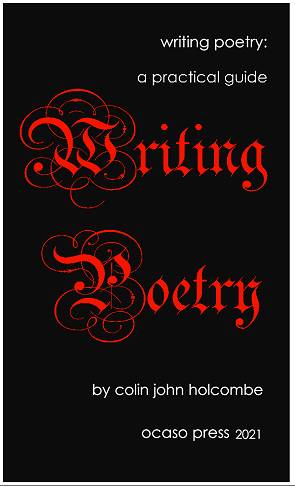An updated and expanded, free 568-page book on verse as an art form — a practical guide to writing poetry in traditional, Modernist and Postmodernist styles. Illustrated with copious examples ranging from Chaucer to contemporary American poets, plus hundreds of Internet links, this guide bridges the gap between self expression and the production of professional work worthy of detailed literary study.

The theory sections explain not only what poets are and have been trying to do, but why verse takes its often stylized forms. The opening chapters cover the theory and aesthetics of verse, genre considerations, sentence structure and rhetoric, stanza forms and word choice, sound patterning, metaphor and imagery, metre and rhyme.
Then
follow chapters on the sonnet, lyrics, rhyming couplets, ode, pastoral
elegy, light verse, blank, narrative and dramatic verse, modernist and
postmodernist styles, and performance poetry.
The book concludes with a step by step guide to verse construction, a
chapter on translating Italian, French, German and Sanskrit poetry into
English forms, and a final 50 page bibliography.
A free pdf writing poetry ebook.
Verse
is a means to an end, a step towards what may, with the right gifts and
effort, become poetry. It enables a piece of writing to be effective,
moving and beautiful.
Verse gives structure to lines, and so liberates words from
their everyday uses and connotations. And words for poets have special
meanings, appropriate uses, associations, connotations, etymologies,
histories of use and misuse. They conjure up images, feelings, shadowy
depths and glinting surfaces. Their properties are marvellous, endless,
not to be guessed at from casual inspection. And each property —
meaning, association, weight, colour, duration, shape, texture, etc. —
changes as words are combined in phrases, rhythms, lines, stanzas and
completed poems. Out of these properties the poetry is built, even if
the end cannot be entirely foreseen but grows out of the very process
of deployment, that continual, two-way dialogue between writer and
poem.
An analogy may help. We are born into language, using its
words and ready-made phrases to get through our busy lives. From those
words and sometimes complete phrases we make poetry — a poetry that is
therefore ever latent in language. What verse does is to select,
organize and shape that language, just as the radio set picks up and
converts into sound what we otherwise can-not hear. Far from
constraining language, therefore, verse gives it greater possibilities,
significance and responsibilities. Verse is an enabling mechanism, but
through terms and traditions that have to be learned.
So this book, which is aimed at those who care for both verse and poetry, that select minority appreciating how its complex
harmonies and silences on the page can be more effective and memorable
than the 'kindling of poetry from the living voice': a worthy aim but
in practice difficult and limiting. Verse is not wholly idiomatic, not
at all natural, and is not to be judged by everyday standards.
Certainly it becomes strained and artificial if it departs too much
from a common currency, but that is not an argument for making poetry
currently so prose-based.
Perhaps insulated by a belief in the superior properties of
free verse, the great majority of would-be poets making up literary
circles and workshops — articulate, well-read and perceptive students —
generally have only the most rudimentary ear for traditional styles in poetry writing.
And if that's an extraordinary situation, it is one repeated in many of
the experimental arts where the critical theory is abstruse and taxing
but often produces something prosaic in the extreme. The craft aspect
is entirely overlooked, though it must be self evident that trying to
write poetry without developing an ear for verse is akin to writing an
opera while remaining ignorant of music. Opera lovers can dispense with
the technicalities and trust their simple passions, but composers and
critics have to study everything possible, from music theory to the
efforts of past composers, generally adding proficiency in some musical
instrument to their skills.
But why so many examples of styles no longer used by serious
poets? Why learn to write rhyming couplets, for example, when few now
can even read them with an appreciative ear? Because:
1. The old styles are still needed for translation from formal
poems in other languages. Free verse forms aren't generally successful.
2. Being the more demanding, the old styles train the ear more
thoroughly, just as contemporary dancers generally learn the basics of
their art through ballet. Not only train the ear, moreover, but help
give the poet a wide dexterity in handling words, all the more needed
in contemporary styles that largely dispense with poetic devices. Some
of the most pleasing free verse was written by the early Modernists, of
course, who enjoyed the best of both worlds.
The emphasis of this book is on the practical, a belief that
poets will learn more of the strengths and weaknesses of all styles by
actually writing them than by reading shelves of literary criticism or
theory.
A free pdf writing poetry ebook.